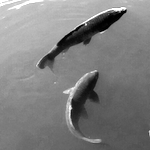Vortex rings are ubiquitous in nature and can be observed in several biological flows, such as the highly efficient aquatic locomotion of jellyfish, squid, and cuttlefish. In such systems, vortex rings are generated through deformable (flexible) orifices as the body actively contracts and expels fluid. In this work, we study the fluid-structure interactions that occur in vortex ring (L/D=3) generation through passive flexible orifices and their influence on thrust (via hydrodynamic impulse). A piston-cylinder mechanism driven by a syringe pump is used to generate a vortex ring in water. Orifices of varying flexibility are made from silicone rubber, and a rigid nozzle is 3D printed for comparison. Nozzle deformations are tracked for the duration of vortex ring formation. Peak deformations are observed both at the instant of piston (fluid) acceleration and deceleration. During steady fluid motion, and after fluid motion ceases, the nozzle experiences underdamped harmonic oscillations as a response to the peak deformations; the material damping ratio and natural frequency are characterized via fast Fourier transform. It is found that nozzle deformations during fluid deceleration are particularly pronounced, and result in a rearrangement of vorticity and generation of secondary vortex structures. Finite-time Lyapunov exponents (FTLE) fields are computed from particle image velocimetry data and are used to characterize the rearrangement and merging of vorticity through vortex ring formation. It is found that increasing flexibility does not monotonically increase hydrodynamic impulse; consistent with previous studies, optimal conditions for augmenting thrust depend on both the material properties (natural frequency, Young's modulus) and the piston motion profile (acceleration/deceleration). The increase of hydrodynamic impulse as a result of nozzle deformation in this work is attributed to both a) the rearrangement of vorticity (increased vortex spacing) and b) the ability of the material to impart elastic potential energy to the flow.

 PDF version
PDF version
